List of figures and tables
| 1.1 | The four phases of the ‘modern journal’, based on an idea from Mari Pijnenborg. From Campbell and Wates (2009) | 4 |
| 1.2 | The rise, fall and rise in circulation of a research journal. From Campbell and Wates (2008) | 5 |
| 1.3 | The journal publishing industry – From Access to Research Outputs: a UK Success Story. The Publishers Association, STM and ALPSP | 7 |
| 1.4 | What do publishers do? From Access to Research Outputs: a UK Success Story. The Publishers Association, STM and ALPSP | 8 |
| 5.1 | Kondratiev waves in history | 100 |
| 5.2 | 5th Great Surge based on ICT | 101 |
| 5.3 | The scale of journal publishers’ technological and content investment since 2000 | 103 |
| 5.4 | Journals in the new research and learning landscape | 111 |
| 5.5 | The online journal article workflow in the 21st century (Taylor & Francis example) | 113 |
| 5.6 | From products to services, and from journals to digital research networks. Inspired by and adapted from a presentation by Stephen Rhind-Tutt, Alexander Street Press: http://alexanderstreet.com/articles/index.htm | 114 |
| 5.7 | Igor Ansoff’s Product/Market matrix | 125 |
| 8.1 | Example of XML-encoded journal metadata | 199 |
| 8.2 | Layout-independent XML data and its use | 200 |
| 8.3 | Example of semantic linking of terms and definitions | 201 |
| 8.4 | Example of a journal article production workflow representation | 203 |
| 8.5 | Reference linking and DOI metadata storage | 204 |
| 8.6 | Example of a book object model and associated business processes | 209 |
| 8.7 | Example of an Enterprise Content Management model | 210 |
| 10.1 | Illustration of an author’s H-index calculation | 262 |
| 11.1 | Composite of information activity in research life cycle | 273 |
| 11.2 | Information extraction: from free text to structured template | 279 |
| 16.1 | Possible allocation of obligations and responsibilities in a contract between publisher and journal editor | 388 |
| 16.2 | Sample template for issues log | 399 |
| 16.3 | Sample template for promises log | 400 |
| 16.4 | Sample template for a communication tracking spreadsheet | 401 |
| 16.5 | Sample meeting checklist | 402 |
| 16.6 | Satisfaction is achieved when perception exceeds expectations | 404 |
| 17.1 | Eight most important factors for authors in 2009 | 419 |
| 17.2 | Report of Newton’s prism experiments | 419 |
| 17.3 | Discovery of Buckministerfullerene | 420 |
| 17.4 | A recent paper from the online edition of Tetrahedron Letters | 420 |
| 17.5 | Comparison of publishing vehicles | 422 |
| 17.6 | Growth in co-authorship levels | 424 |
| 17.7 | Results of the Core Trends study | 426 |
| 17.8 | Proportion of downloads at 6, 12 and 18 months | 434 |
| 2.1 | The common forms of pre-publication peer review | 27 |
| 6.1 | Illustrative profit & loss (P&L) sheet ($, thousands) for a hybrid journal’s position at the end of July | 164 |
| 7.1 | Recommended retail price scale for books (based on a sample from half a dozen large publishers), largely hardbacks (except textbooks) of around 300 pages | 182 |
| 7.2 | Experiments in open content book programmes | 183 |
| 7.3 | Cost sheet for a monograph retailing at £50 (per unit, assuming 400 copies sold, and digital printing) | 184 |
| 14.1 | Ethical policies and resources of some publishers | 345 |
| 17.1 | Communication dimensions | 429 |
| 17.2 | An example of an oral lecture | 429 |
| 17.3 | Open access (OA) types | 433 |
| 19.1 | Most common areas (per cent) of learning or development undertaken in the past 12 months | 462 |
| 19.2 | Future skills gaps in publishing | 468 |
..................Content has been hidden....................
You can't read the all page of ebook, please click here login for view all page.
